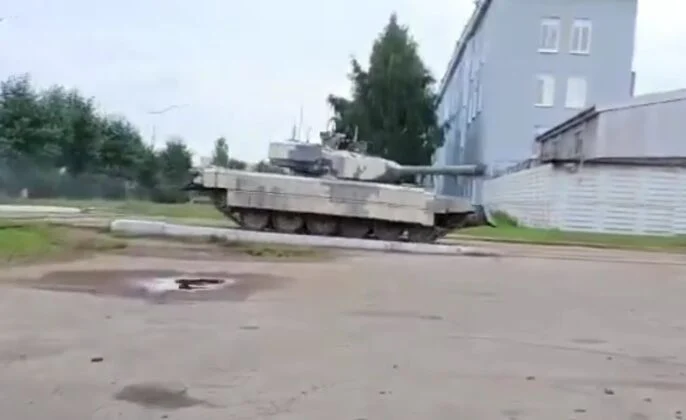
We’re getting our first full look at Russia’s ‘Shturm’ robotic tank complex.
The new combat system was first identified during recent field trials, where it appeared for the first time in its complete configuration—featuring both a remotely operated assault vehicle and a command-and-control vehicle based on a modified T-72 chassis.
Developed by Uralvagonzavod for the Russian Ministry of Defense, the new system is intended to lead assault operations in high-risk environments, particularly urban terrain. Its emergence in full form suggests the project has entered a new phase of testing after years of limited disclosures and isolated component demonstrations.
Open-source imagery from recent field trials confirms that the Shturm system now includes at least two key components: a robotic tank capable of being remotely operated (optionally crewed), and a mobile command post built on a T-72 or T-90 tank chassis. This marks the first time the complete robotic complex—featuring a functioning control vehicle and a combat vehicle—has been publicly spotted in testing.
Uralvagonzavod is developing the system on order from the Russian Ministry of Defense. The objective is to create a robotic assault unit that can lead the first echelon of offensive operations, detect enemy firing positions, and either engage them directly or relay coordinates to other units.
The combat vehicle—identified as Combat Vehicle No. 1—is equipped with a shortened 125mm D-414 main gun (barrel length 4000 mm), an autoloader with 22 rounds, and a 7.62mm PKTM coaxial machine gun. The vehicle also features a bulldozer blade for obstacle clearing and a comprehensive protection system designed to defeat infantry anti-tank weapons using shaped charges. A variant with a 152mm gun is also reportedly under development.
Each robotic tank is designed to operate in close-quarter combat, especially in urban terrain. In a departure from earlier Russian unmanned systems, the Shturm complex prioritizes human-in-the-loop remote control, using a separate vehicle to manage battlefield movement and engagement.
The command vehicle, mounted on a tank chassis, serves as a mobile remote-control station. It is intended to manage a platoon of robotic tanks within a radius of up to 3 kilometers. Like the combat vehicles, it is equipped with full-coverage protection against infantry anti-tank threats.
The Shturm complex includes multiple combat configurations. Aside from the main gun variant, Combat Vehicle No. 2 carries a launcher system for RPO-2 “Shmel-M” thermobaric rocket flamethrowers. Combat Vehicle No. 3 is fitted with twin 30mm 2A42 automatic cannons, a PKTM machine gun, and an RPO-2 launcher. Combat Vehicle No. 4 is armed with 16 unguided 220mm thermobaric rockets of the MO.1.01.04M type, capable of affecting up to 25,000 square meters.
All variants include bulldozer blades and the same all-aspect anti-RPG protection suite. Remote control of these systems allows operations at speeds up to 40 km/h.
This is the first confirmed instance in which both the robotic tank and its command unit were seen together during live testing. The integration of a high-mobility control vehicle into the system indicates that Russian developers are working to address previous shortcomings in operational range and coordination, issues that plagued earlier systems such as the Uran-9.
The Shturm complex is being developed to perform high-risk roles that would be too dangerous for crewed platforms—such as breaching fortified positions and flushing out enemy ambushes. The inclusion of a command vehicle suggests an emphasis on sustained tactical deployment rather than limited demonstrations.